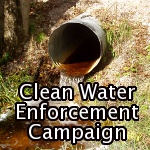The California Sportfishing Protection Alliance, California Water Impact Network and AquAlliance submitted joint comments September 3, 2019 on the Bureau of Reclamation’s Draft Environmental Impact Statement (DEIS) for the Long-Term Operations of the Central Valley Project and the California State Water Project.
The DEIS proposes to weaken fishery and environmental protections so that the Reclamation can increase water exports out of an already severely degraded Delta ecosystem. Reclamation justifies these changes under the pretense of “new science”. In their 58-page comment letter, CSPA and its allies detail how the DEIS is both factually incorrect and fails to comply with the law.
Central Valley Project (CVP) and State Water Project (SWP) operations are currently based on biological opinions issued in 2008 and 2009 by the U.S. Fish and Wildlife Service (USFWS) and the National Marine Fisheries Service (NMFS). In August 2016, Reclamation and the California Department of Water Resources (DWR) reinitiated Endangered Species Act (ESA) consultation with NMFS and USFWS on the future joint operation of the CVP and SWP. This will require new biological opinions that the DEIS purports to analyze, even though these biological opinions are not yet complete.
The DEIS states that the purpose of the new consultation is to evaluate “alternatives to maximize water supply deliveries and optimize marketable power generation consistent with applicable laws.” In their comments, CSPA and its allies describe how this project purpose is unlawfully narrow, ignoring evaluation of reasonable alternatives that would not increase water supply deliveries and optimize power generation.
The comments describe how the Preferred Alternative in the DEIS, Alternative 1, as well as Alternatives 2 and 3, would cause jeopardy under the ESA and adversely affect critical habitat. They would thus be inconsistent with applicable law, and as such are not reasonable alternatives. Increasing south Delta exports is likely to cause further environmental degradation in the Central Valley and add to the risk of extinction of many Central Valley threatened and endangered species, including salmon, steelhead, sturgeon, and smelt. Removing existing ESA restrictions on reverse flows in the Delta and weakening already inadequate water temperature requirements in the Sacramento River are two of the most damaging proposed actions in the Long Term Operations (LTO) Plan.
The DEIS fails to quantify the benefits of a healthy ecosystem and to show how Reclamation makes valuations of resources other than water supply and power generation and sales. The DEIS also fails to describe how Reclamation and DWR have serially violated existing ESA and other legal constraints on their operations, and how the State Water Board has failed to take enforcement actions against these violations.
The DEIS proposes that the Preferred Alternative would make compliance with the Central Valley Project Improvement Act (CVPIA) revocable at the discretion of the Secretary of the Interior. The DEIS fails to disclose that such action would be contrary to law and would unilaterally overturn the will of Congress.
Among the many serious faults of the DEIS, Reclamation appears to include as part of the Preferred Alternative a raise of Shasta Dam and Shasta Reservoir. The DEIS fails to disclose that a Shasta raise would be contrary to California law.
To comply with the National Environmental Policy Act, the Bureau of Reclamation must recirculate the DEIS with a proposed Action and alternatives that will allow operation of the CVP and SWP to consistent with the ESA, the CVPIA, and other applicable law.
For the complete comment letter, click here.









